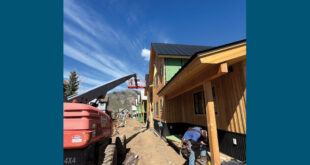One more week to appeal the valuations
All over Gunnison County, assessed property values are on the move. But despite a nationwide dip in housing prices, some area property owners aren’t seeing their property values move in a direction that will lighten their tax load.
County property owners got the latest mass assessment from the assessor’s office on May 1, and Crested Butte town residents were the only ones to see their home values drop.
Business owners in town weren’t so lucky.
Big Horn Real Estate owner Dan McElroy owns commercial space that he leases out, and despite showing the assessor’s office proof of its value, his appeal for a lower assessment was refused.
“I’m getting upset because they’re telling me that the value of my property, which isn’t [in the town’s commercial center] on Elk Ave., is 50 percent higher than where it should be,” says McElroy.
The effect of those values won’t be felt until next January, when taxes are collected for the county’s various taxing authorities, such as the school district and library.
This year presents a unique situation and there are more than a few people protesting the valuations through the county assessor’s office.
The valuations are calculated from a time when prices were high. However, nearly all homes in the county have decreased in value since then.
The 26 different authorities are mandated by Colorado law to use assessed home values to distribute the current “recession era” tax burden using home values from a boom time.
The problem, according to Gunnison county assessor Kristy McFarland, is timing. The assessment that residents got in the mail was based on the prices comparable homes sold for in a specific area between July 1, 2006 and June 30, 2008.
“What is happening in the market today will be reflected in the next reappraisal,” she says. But that won’t happen for another two years.
And McElroy isn’t sure it ever will.
He says, “I have a sneaking suspicion that they may adjust the property values next time around, but the mil levy will increase to keep our taxes about the same. It will be tough for them to take a smaller income stream.”
The assessor’s office looks at four “economic areas” in the county, as well as specific neighborhoods, to compare the prices of homes that sold in the last two years with those being assessed. A home’s design and construction, as well as any amenities it might have such as a garage or finished basement, are also factored into the final assessment.
The town of Crested Butte is the only municipality in the county that is designated as its own economic area, due to its status as a National Historic District and its strict architectural regulations.
Otherwise, an economic area is defined as “a grouping of neighborhoods that have similar economic forces or geographic location.” The other locations are the area around and including the city of Gunnison, the upper East River valley, including Mt. Crested Butte, and properties in rural parts of the county.
During the last two years, average home prices in the county have increased steadily from just over $300,000 to nearly $400,000. The only place that wasn’t the case is within the town of Crested Butte, which experienced a home value drop in 2007 that skewed the results of the most recent valuation.
What has decreased overall, however, is the number of homes being sold. In 2003, Gunnison County saw a peak in home sales, with more than 400 sold. Last year, the number was just 150.
“Fewer sales does not automatically mean lower valuation,” says McFarland. “In many instances, the sales that occurred prior to June 30, 2008 indicated higher sales prices than the previous valuation.”
But the number of homes being sold isn’t part of the metrics being used to assess property value.
McElroy is confident that a low number of sales will translate into lower property values over time. He points to that type of adjustment as being part of the real estate cycle.
“You look at any cyclical trend in the country and that’s what happens: the volume goes down and then people get tired of not selling their properties so the price is reduced. We’re seeing that now—we just hadn’t seen it when the appraisal ended.”
Property owners who aren’t satisfied with the assessment of their home’s value have until June 1 to appeal the valuation. McFarland says the number of protests received so far this year is on pace to meet past assessment cycles.
Of the 22,000 parcels owned by individuals in the county, McFarland says she expects to see 1,500 to 1,800 appeals, which are reviewed by a “team of appraisers.” Because the protest period hasn’t ended, she says the appeals received so far haven’t been counted.
According to McFarland, some things people might look at are the same things an appraiser uses to value a home, like location, square footage and the quality of construction. A small error in any of those areas, known as an inventory, could change the value of a property dramatically.
“Because an accurate inventory is a critical piece in a correct valuation, we encourage owners to notify us if they feel that they have any corrections,” she says.
People protesting an assessment should also include things about the property that make it unique in the area, which might boost the value but would be hard for an appraiser to judge.
Taxpayers can appeal the valuation until the end of the day on Monday, June 1, and by Tuesday, June 30, the assessor will return a Notice of Determination to those who filed an appeal of their valuation.
 The Crested Butte News Serving the Gunnison Valley since 1999
The Crested Butte News Serving the Gunnison Valley since 1999

